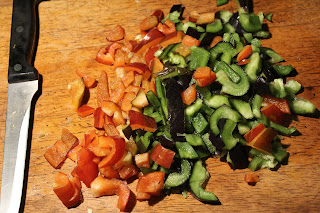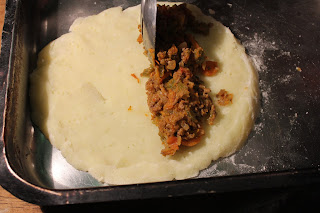Before we came to live in France we had a house purchase fall through in the UK, in Cornwall, an old house on a hill overlooking the sea. In a strange twist of fate we ended up across the channel in an old French house and if you climb up one of the trees in the garden, you can still see almost the same bit of sea.
 |
So although we love living here, every now and again when we have a pang of remorse for what could have been and want to wallow in nostalgia, we make a Cornish Pasty for our supper.
What is a Pasty and How Does it Differ From a Pie
What Goes Into a Pasty?
The answer is anything and everything and there's an ancient myth that the Devil would never cross the Tamar river into Cornwall 'because he was afraid of ending up in a pasty'. There are some wonderful pasty shops in Cornwall which prove this point and have serried ranks of seemingly hundreds of varieties and I remember a particularly wonderful one in Tintagel, which ships its pasties around the World! Basically however, whatever you would put on a plate to eat for your lunch or dinner can be wrapped in pastry and made into a pasty.
....and as always there was a gourmet version:
And half cut down, a pasty costly-made,
Where quail and pigeon, lark and leveret lay,
Like fossils of the rock, with golden yolksImbedded and injellied.........
Alfred, Lord Tennyson, Audley Court (1842)
Ingredients - Potato Pastry Dough
Makes 3 pasties - 1 large, 1 medium, 1 small
4 large potatoes (2¾lbs or 1.25kg)
Lard or butter for greasing the baking tin/pan
Rice flour for dusting
Salt and black pepper
Ingredients - Filling
1½ cups - 12oz - 350g of minced beef
1 onion
2 Sweet Bell Peppers - I used red and black
1 carrot
2¼ cups - 1 Imperial Pint - 500ml of tomato purée (mine's homemade, so you will need less if it is concentrated)
½ teaspoon each of: coriander seeds, mustard seeds and cumin seeds
3 bird's tongue aka pili pili aka piri-piri chillies
Preheated Oven
430°F - 220°C
Prepare the Potatoes
Peel the potatoes, chop into chunks and boil until they are firm but can be easily pierced with a fork. Set aside to cool. Mash with a hand masher.
Prepare the Filling
Peel and chop the onion.Peel and slice the carrot.
Chop the peppers.
Dry fry the spice seeds and chopped chillies in a heavy frying pan until the mustard starts to crackle.
Place seed into a pestle and mortar and grind to a fine powder.
Soften the onion in a heavy-bottomed pan with a little lard.
Add peppers and carrot and continue until they are soft.
Add the spices.
Stir and cover to let the flavours develop (about 5 minutes).
Add the meat and mix well.
Lower heat and leave to cook slowly until meat is cooked (about 20 minutes).
Add tomato tomato purée heat mixture, stirring frequently, until it starts to simmer.
Take off heat. Leave to cool.
Prepare the Potato Dough
Dust board and rolling pin with rice flour.Work the mashed potato into a ball.
Break the dough in half and reform into two balls.
Take one dough ball and roll out on the board in an ellipse shape and to a thickness of around ⅛" to a ¼" - 3mm to 6mm.
For this large pasty I am going to cheat and leave it lying on its side but in fact some traditional Cornish Pasties are made in this way. So prick the pastry around a half of the dough that will be folded over the filling. This will keep the dough crisp as it allows any steam to escape from the filling.
Grease your pie tray.
Slide the pastry from the board onto the tray.
You are now ready to fill the large pasty.
Make the Pasty
Remove spoonfuls of filling with a slotted spoon to allow for the liquid to drain from the mix. This excess liquid can be made into a sauce to accompany the pasty or saved and if needed, frozen as a stock for future use.
Place enough filling in one half of the pasty shape to fill it but allow for the easy closure and sealing of the dough.
Fold over the dough to cover the filling, making any necessary adjustments by adding or subtracting mash.
Seal the pasty by pinching or crimping the edges between the index finger and thumb.
Divide the rest of the dough, taking ⅔ to make the medium pasty and leaving the remainder for the small.
Repeat as for the large pasty but once rolled both these sizes can be moved with a fish slice onto the tray. The pastry should also be pricked everywhere except where the filling will go (see photo and below).
Place the filling around the middle of the ellipse, leaving room to form the handles at each end.
Fold the edges up to meet each other and crimp together.
Variations on a Theme
These pasties make great festive snacks. We often make tiny pasties as appetisers or for a first course.
There is a type of pasty that goes even further with the 'full meal in a pastry wrapper' idea and has two chambers within, one of which is filled with jam. That way you get dessert too! I'm not sure how this would work with potato but it is definitely something we will be trying with the pastry version.
All the very best,
Sue
© Sue Cross 2020
RELATED POSTS
Potato heart-shaped canapés à la provençale Gluten-free
This Mazagran is one with a difference, for when I looked at making an à la provençale version..read moreIndividual Potato Pies à la Clamart -Gluten-free
Mini Potato Pies à l'Andalouse - Gluten-free
French Potato Pies With Braised Red Cabbage - Mazagran à la flamande - Gluten-free
Kartoffelpuffer With Fresh Fig & Prosciutto Di Parma - Gluten-free
Kartoffelpuffer aka German potato pancakes are used for both savoury and sweet toppings. As a base for a gluten-free dish kartoffelpuffer are extremely...read more
Baked Organic Quail Egg in a Nest - Gluten-free
A variant of a dish we used to eat regularly at home on
the farm when I was a child. ..read moreSausage & Mash on a Stick - Gluten-free
A British traditional recipe on a stick. One of the Tavern dishes which was not pastry-based and is still a favourite pub meal today...read more
















